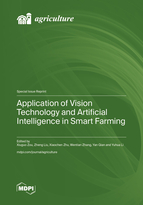Application of Vision Technology and Artificial Intelligence in Smart Farming
A special issue of Agriculture (ISSN 2077-0472). This special issue belongs to the section "Digital Agriculture".
Deadline for manuscript submissions: closed (10 July 2023) | Viewed by 41115
Special Issue Editors
Interests: microclimate analytics of poultry houses; intelligent agricultural equipment; smart farming; non-destructive detection of meat quality; agricultural robot
Special Issues, Collections and Topics in MDPI journals
Interests: intelligent sensing, measurement, and instrumentation; diagnostics, prognostics, and health management; predictive maintenance; digital twins; computational intelligence and data/information fusion; non-destructive testing and evaluation; machine/computer vision; data analytics and machine learning
Special Issues, Collections and Topics in MDPI journals
Interests: climate-smart agriculture; AI meteorology
Special Issues, Collections and Topics in MDPI journals
Interests: prediction model; computer simulation
Special Issues, Collections and Topics in MDPI journals
Interests: intelligent agricultural equipment; three-dimensional reconstruction
Special Issues, Collections and Topics in MDPI journals
Interests: intelligent agricultural equipment; disease detection
Special Issues, Collections and Topics in MDPI journals
Special Issue Information
Dear Colleagues,
Computer vision (CV) and artificial intelligence (AI) have been gaining traction in agriculture. From reducing production costs with intelligent automation to boosting productivity, CV and AI have massive potential to enhance the overall functioning of smart farming. Monitoring and analyzing specific behaviors of livestock and poultry in large-scale farms based on CV and AI to improve our knowledge of intensively raised livestock and poultry behaviors in relation to modern management techniques, allowing for improved health, welfare, and performance. In the field of planting, CV approaches are required to extract plant phenotypes from images and automate the detection of plants and plant organs. AI approaches give growers weapons against pests. Smart farming requires considerable processing power. The application of CV and AI helps crops to progress toward perfect ripeness.
This Special Issue focuses on the application of CV and AI in smart farming, including breeding and planting. Topics of interest include but are not limited to the following: design and optimization of agricultural sensors, behavior recognition of livestock and poultry based on vision technology and deep learning, automation technology in agricultural equipment based on vision technology, design and optimization of robots for livestock and poultry breeding based on vision technology and artificial intelligence, non-destructive detection of meat quality, and agricultural big data analytics based on sensor data and deep learning. Original research articles and reviews are welcome.
Dr. Xiuguo Zou
Dr. Zheng Liu
Dr. Xiaochen Zhu
Dr. Wentian Zhang
Dr. Yan Qian
Dr. Yuhua Li
Guest Editors
Manuscript Submission Information
Manuscripts should be submitted online at www.mdpi.com by registering and logging in to this website. Once you are registered, click here to go to the submission form. Manuscripts can be submitted until the deadline. All submissions that pass pre-check are peer-reviewed. Accepted papers will be published continuously in the journal (as soon as accepted) and will be listed together on the special issue website. Research articles, review articles as well as short communications are invited. For planned papers, a title and short abstract (about 100 words) can be sent to the Editorial Office for announcement on this website.
Submitted manuscripts should not have been published previously, nor be under consideration for publication elsewhere (except conference proceedings papers). All manuscripts are thoroughly refereed through a single-blind peer-review process. A guide for authors and other relevant information for submission of manuscripts is available on the Instructions for Authors page. Agriculture is an international peer-reviewed open access monthly journal published by MDPI.
Please visit the Instructions for Authors page before submitting a manuscript. The Article Processing Charge (APC) for publication in this open access journal is 2600 CHF (Swiss Francs). Submitted papers should be well formatted and use good English. Authors may use MDPI's English editing service prior to publication or during author revisions.
Keywords
- agricultural sensors
- behavior recognition of livestock and poultry
- agricultural automation equipment
- agricultural intelligent robots
- intelligent robotic arms
- non-destructive detection of meat quality
- agricultural big data analytics











